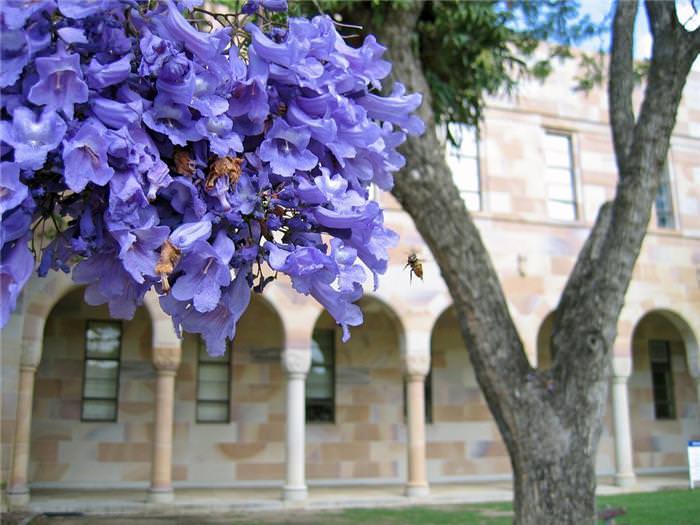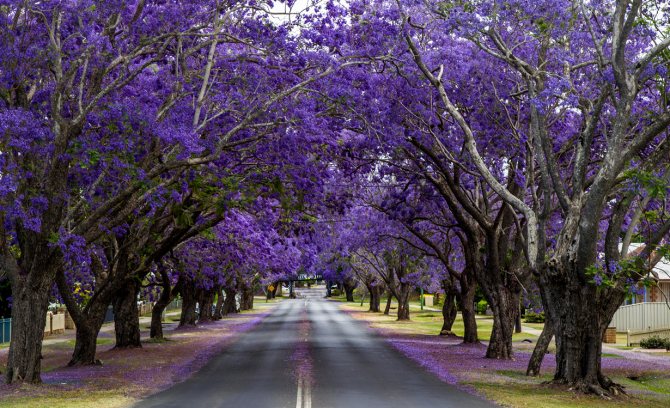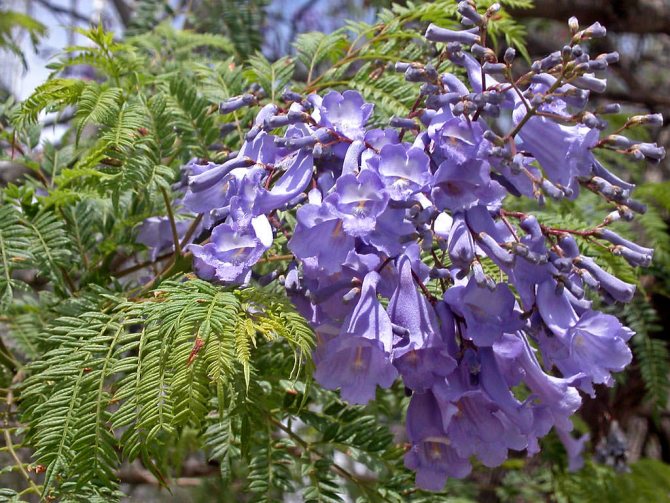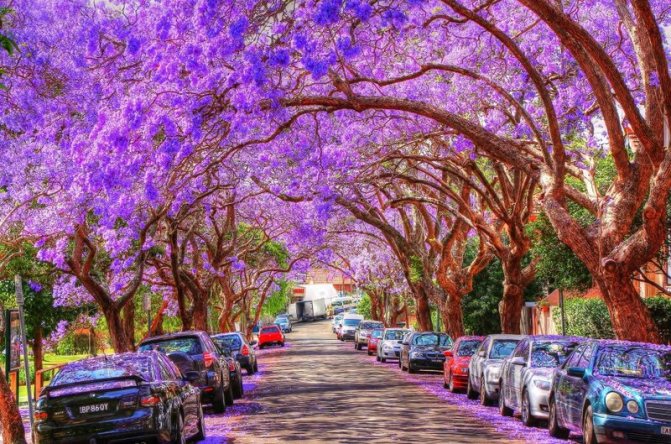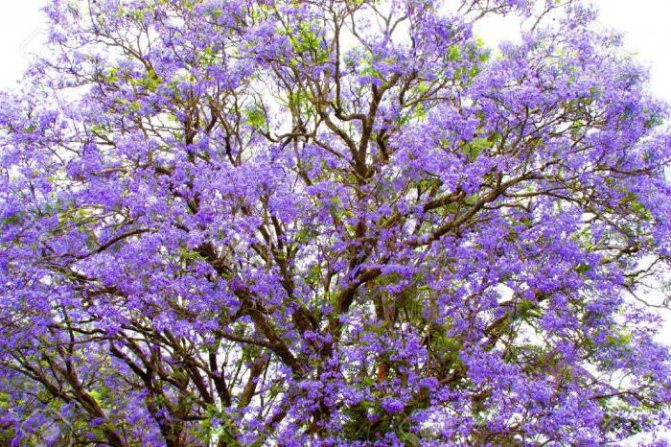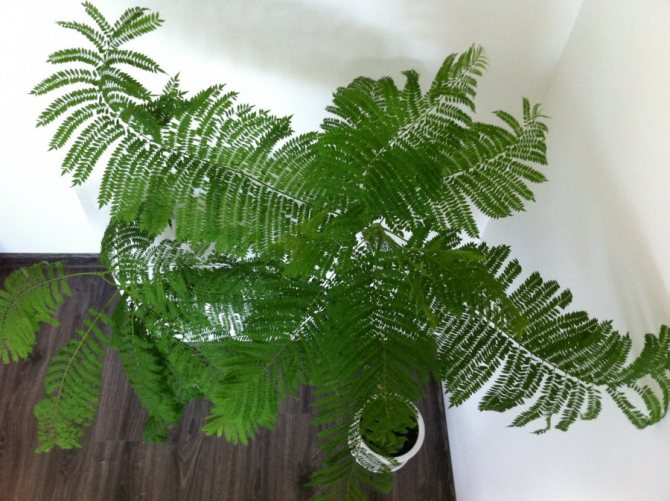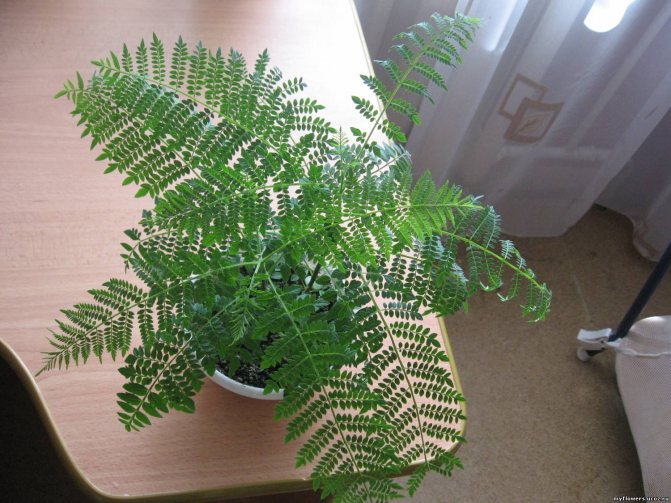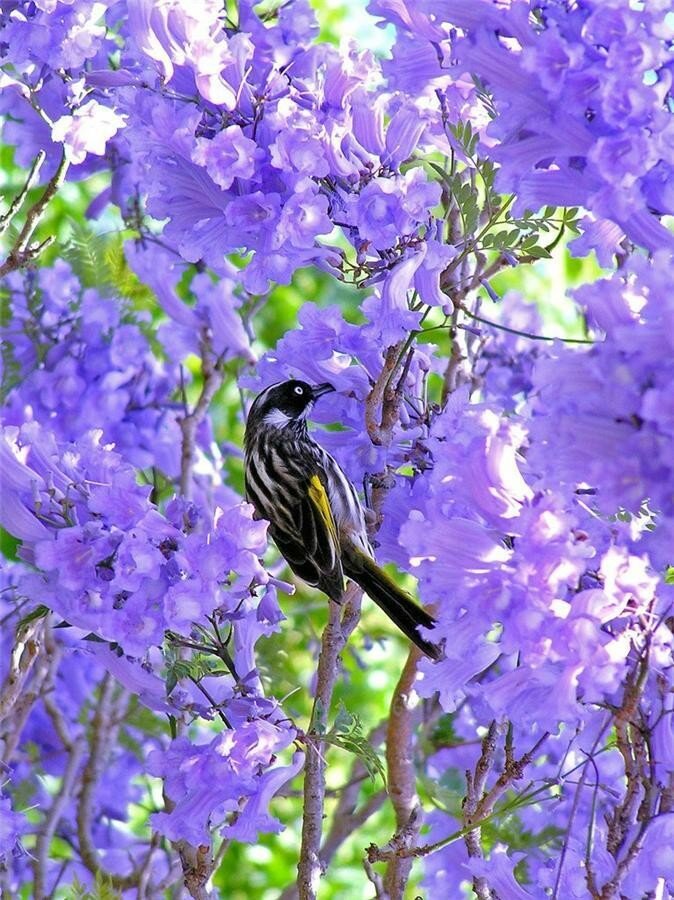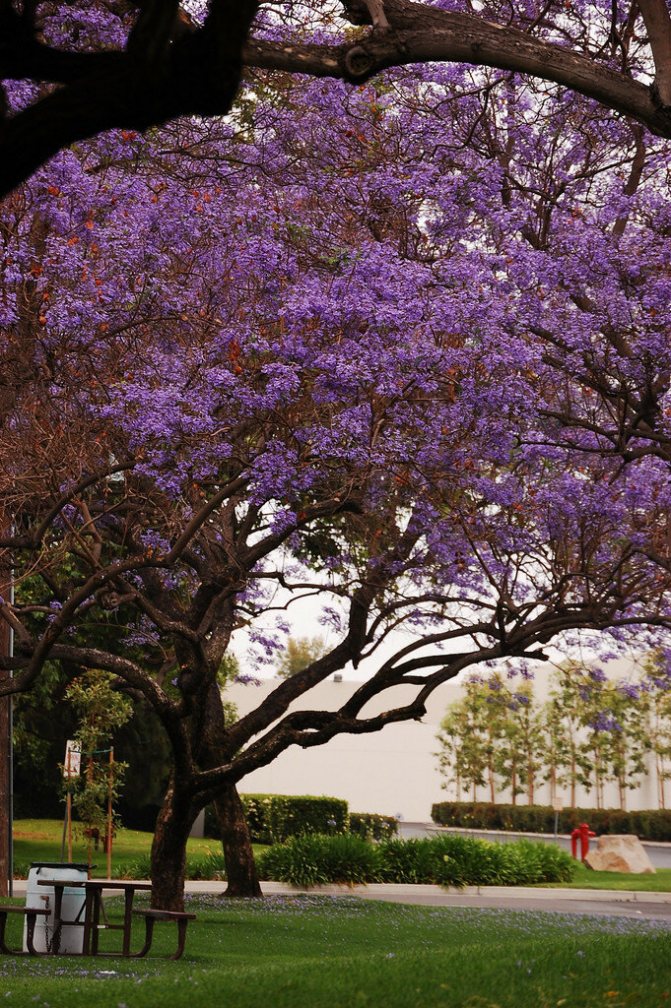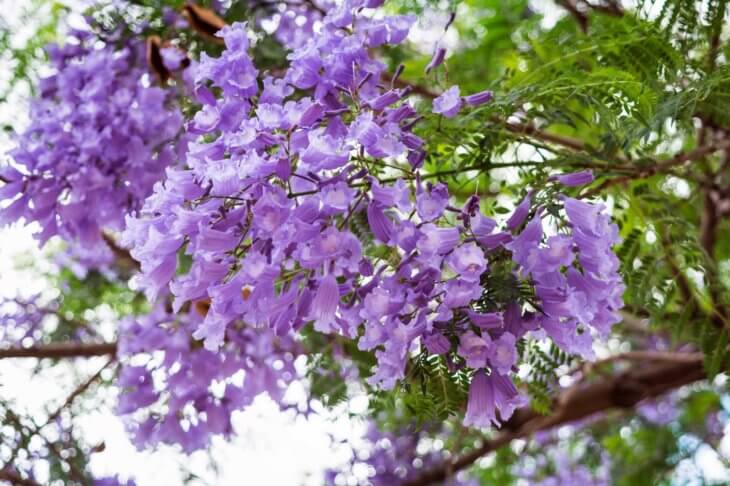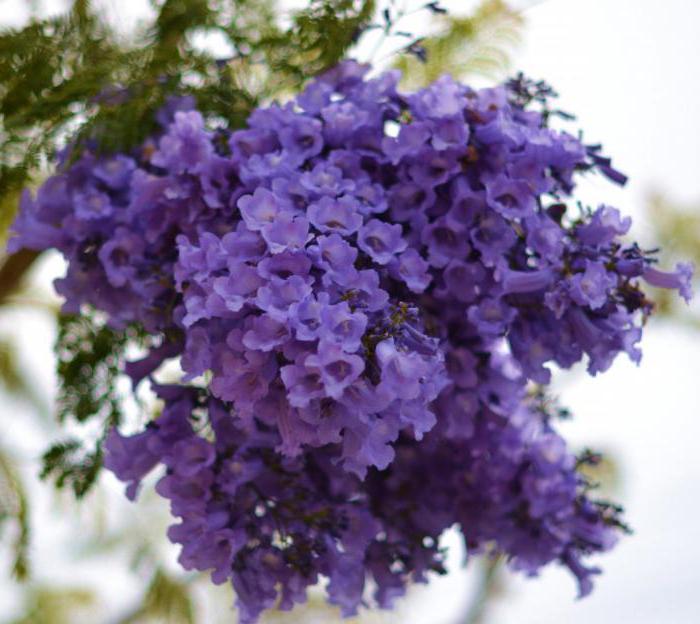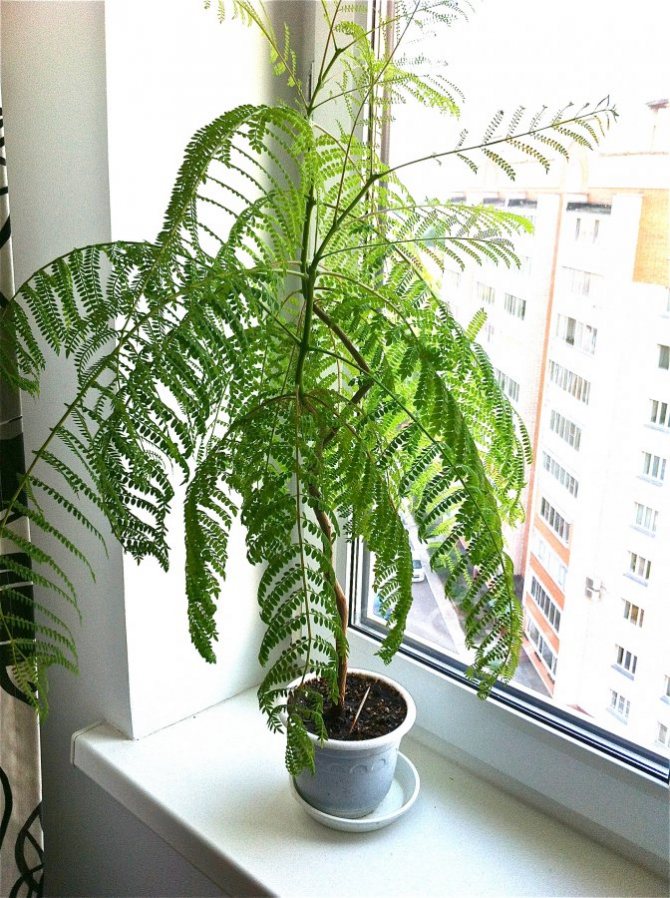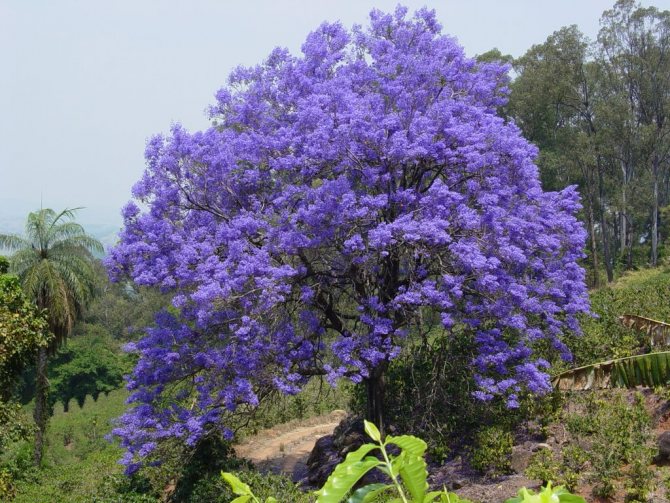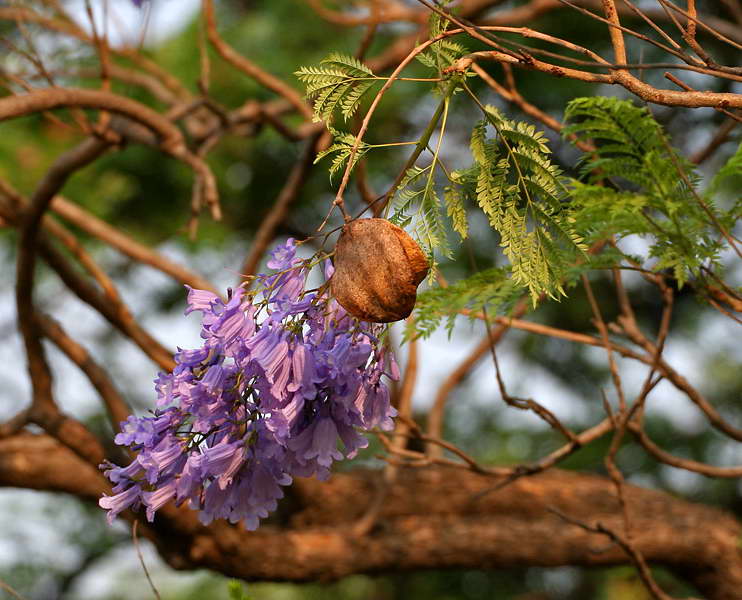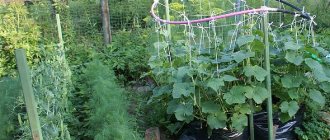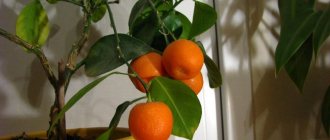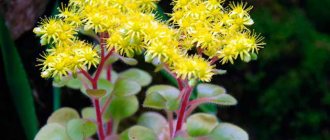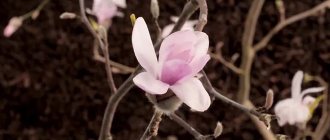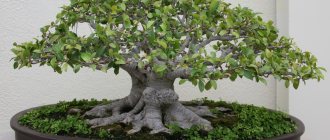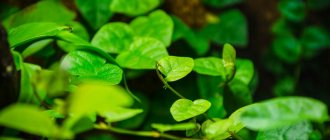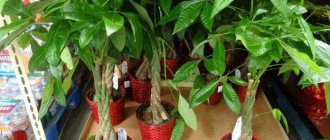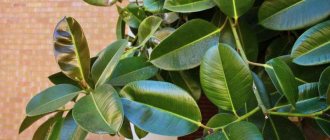An unusually beautiful jacaranda tree grows on the damp river banks in the tropics of Brazil and South America. This is a plant from the Bignoniev family. They say it brings good luck. Often in the house where the child was born, locals plant a jacaranda, the so-called violet tree.
In Australia, the jacaranda blooms in October-November. This time coincides with the end of the school year, the beginning of exams for schoolchildren and students. In this regard, residents call it - examination. A flowering broom falling on your head will bring good luck to the one going to the exam.
An evergreen rosewood tree of medium to large size, appreciated not only for its decorative properties, but also for its wood. There are about fifty species of this plant.
Acquaintance with Jacaranda
Jacaranda has many names: violet, fern and rosewood. Its main habitat is Latin America, where hundreds of tourists from all over the world come to admire the mesmerizing jacaranda bloom and plunge into the most fabulous atmosphere.
Rosewood grows only in warm regions, where the air temperature is always higher than +7 degrees, therefore, in colder regions, jacaranda grows only indoors.
In nature, jacaranda can reach as much as 20 meters in height, but do not be alarmed, when grown in artificial conditions, the height of the tree can be adjusted, usually jacaranda does not grow higher than 3 meters.
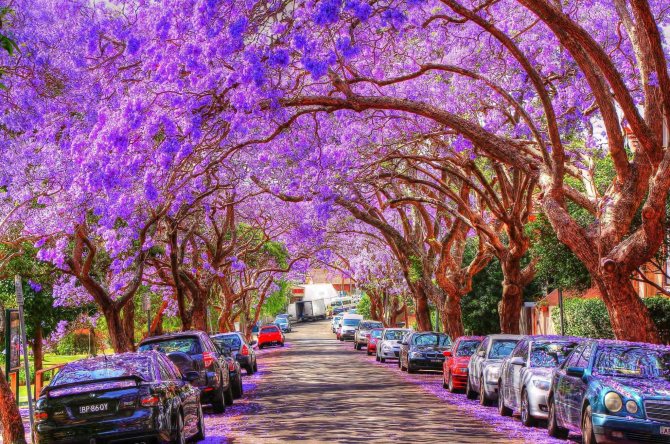
Jacaranda is very fond of its growth in the homeland. The tree is very often planted near educational institutions. It is believed that a flower that falls on the head of a schoolchild or student will certainly help pass all the exams perfectly.
In Australia, very often this tree is planted near their home in honor of the birth of a child. It is believed that jacaranda will bring happiness and good luck to a new resident of the state. From the 30s and 40s, in some maternity hospitals, young parents were given a seedling of this beautiful tree at discharge.
Care rules
- Air temperature... In the spring-autumn period, the temperature should not drop below +22 ° C. At other times of the year, it is better for the plant to be kept at a temperature of about +18 ° C.
- Lighting... When growing jacaranda at home, it needs a lot of light. She will feel most comfortable on the western and eastern sides of the house. If the plant grows on the south side, then during the day it must be shaded due to the adverse effects of direct sunlight.
It must be remembered that with one-sided lighting of a tree, deformation of its crown is possible. - Watering... Regular watering is essential for good plant growth. When changing leaves, its amount is reduced. Watering time is determined by the dried topsoil. To moisten the soil, you must use pre-infused water.
- Air humidity... Considering that the homeland of jacaranda is the tropics, high humidity should be provided for it. It must be sprayed daily with warm water.
- Top dressing... In the spring-summer period, the plant needs to be fertilized about 1 time per month with special means.
During the period of dropping leaves and in the autumn-winter period, it is not fed. - Crown pruning... To obtain a beautiful and dense crown, young shoots of the tree must be pinched in the spring. Since the growth of the jacaranda is quite fast, the trunk becomes bare over time.
Growing jacaranda in Russia
In Russia, jacaranda grows only in the botanical gardens of the Crimea. In other places, it is quite possible to grow it as a houseplant.


It is easy to grow jacaranda at home from seeds, which are now sold in almost any specialty store. However, it is worth remembering that a houseplant will rarely bloom. In addition, there is a high probability that the jacarnade will not bloom at all at home.
Photo gallery
In indoor conditions, you can only grow mimosa jacaranda. It is better to keep it in rooms with a high ceiling, since it reaches a height of two meters. Before growing, the jacaranda must be trimmed. More suitable for greenhouses and "winter gardens" than for a standard room in a Russian apartment.
It is non-toxic, does not affect air purification, does not emit any harmful substances. Does not belong to the class of poisonous, not harmful to children, adults and pets.
Outwardly, it is often compared to sakura, jasmine and lilac. But in indoor conditions, you practically will not find flowering, so it resembles an ordinary plant with a beautiful stem and graceful leaves.
Crown formation
In order for the jacaranda to have a compact size and look dignified, it is very important to trim the ends of the shoots every spring. If you do not do this, the plant will grow rapidly, resulting in a bare trunk. With this, alas, you can no longer do anything.
If you wish, you can make a bonsai-shaped crown. For this, the top of the trunk must be pinched, and the side branches must be bent with the help of small weights to give the desired shape. When the branches are dense enough, the weights can be removed.
Most importantly, do not forget to trim the top and remove excess branches to maintain the beautiful shape of the plant.
Description of the species
Jacaranda is a prominent representative of the Bignoniev family. The genus includes about 50 species of evergreen trees of large or medium size. The homeland of the majority is South America. For normal growth, lush flowering, the plant needs a climate of the tropics and subtropics.
Jacaranda grows quickly, the average height of the tree is 15-20 m. In favorable conditions, it can grow up to 35 m. A tree with a large spreading crown, a wide, straight trunk. The leaf plate is large, ovoid or elongated-oval in shape with a pointed end, outwardly resembling a fern or mimosa leaf.
The main feature of the plant is its flowers. They are collected in racemose or paniculate inflorescences, up to 45 cm long. The flowers are small, resembling a tube, about 5 cm long, slightly pubescent on the outside. With full opening of the petals, their diameter is about 3 cm. The aroma is intense, but at the same time light and unobtrusive with sweet-honey notes. The color can be different, depending on the variety. There are flowers purple, lilac, whitish, cream, purple. Some species have flowers with small blotches, which are lighter or darker by several tones compared to the main color.
The violet tree blooms twice a year in spring and autumn for two months. Spring blooms are more lush. It ends with the appearance of fruits that resemble a capsule about 5 cm long. Inside the capsule there are seeds equipped with a translucent wing. Thanks to him, seeds can spread over long distances.
In countries with favorable growing conditions, jacaranda is used to decorate streets, parks and squares.Valuable wood is used for the manufacture of luxury furniture, various decorative items, for the decoration of which precious stones and precious metals are used, and even musical instruments. The wood is durable, it lends itself well to processing. After polishing, the core becomes brown with a purple tint and a pleasant floral scent.
How to grow jacaranda from seeds
So, you have acquired the coveted bag of jacaranda seeds, you can not wait to plant them sooner, in order to wait for the first shoots. You should not plant seeds directly into the ground, for a start, we soak the seeds in water with the addition of Zircon, Epin or another stimulant.
In such a mixture, we leave the seeds for about 5 hours, then the seeds can be sown in loose soil to a depth of no more than one centimeter. The soil must be moist when planting. After planting, the container must be covered with a film and the future plant must be placed in a warm and bright place.
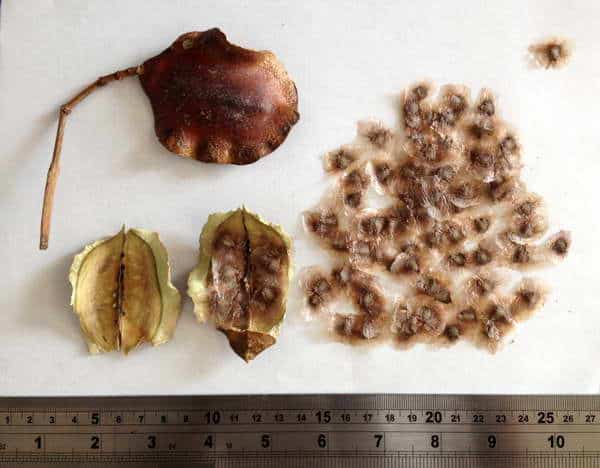

Usually, the first shoots appear after 10 days, provided that the seeds were of good quality. If the seeds were not quite good, then the seedlings will have to wait a long time.
When the sprouts get stronger, they can be transplanted into a separate pot by transferring them.
Possible growing difficulties
Many growers characterize jacaranda as an unpretentious plant that is resistant to diseases and pests. But if the rules of agricultural technology are violated, problems may arise: the leaves turn yellow, curl or fall off, rot the roots, attack pests. To prevent the death of a plant, you need to respond in a timely manner to any changes in its appearance. If the leaves are faded, curled, or yellow, the plant should be inspected for pests. Some types of insects are so small that they are not immediately visible. In this situation, it is necessary to treat the plant with a universal insecticidal preparation.
If leaves fall off during winter, this should not be a cause for concern. A natural seasonal process takes place. But if this happened at an unspecified time and quickly, then the reason for this may be a sharp change in the temperature regime in the room or overdrying of the soil. The crown can become thinner if hard water is used for irrigation after drying the soil.
Jacaranda is resistant to fungal infections. But with overflow and stagnation of water, root rot can begin. Good drainage will help to avoid this. An unnatural elongation of the shoots can often be observed. This is the first sign of developing chlorosis. To get rid of the problem, you need to add preparations containing iron to the soil.
With proper care and adherence to all the rules of agricultural technology, you can grow a beautiful plant that will become a real decoration of any interior.
Propagation by cuttings
Another way to propagate jacaranda is by cuttings. Usually this method is relevant in the spring, when the plant is pruned annually.
The cuttings should be about 8 centimeters each. They need to be placed in a container with warm water or planted in a peat-sand mixture. It is important that the cuttings are kept warm.
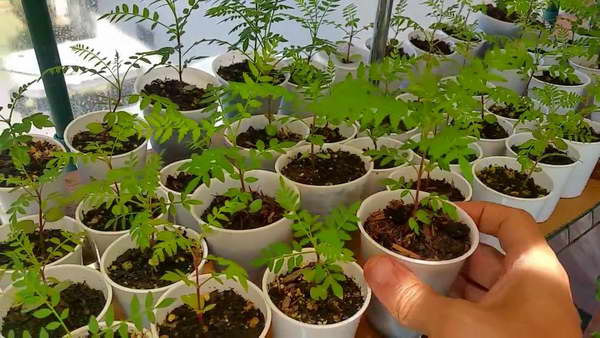

When the roots have reached at least one centimeter, the cuttings can be transplanted into a separate pot.
Where is it used?
There are several ways to use this tree:
- The most popular use of the plant is for decoration... In southern America and Europe, it is used to decorate parks, gardens and streets;
- Valuable wood use for the manufacture of various furniture and wooden luxury goods;


Kitchen furniture

Jacaranda wood guitar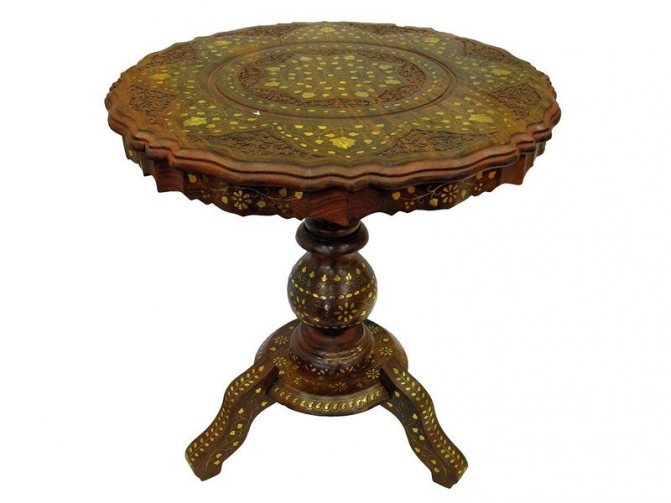

Rosewood table (polysandra)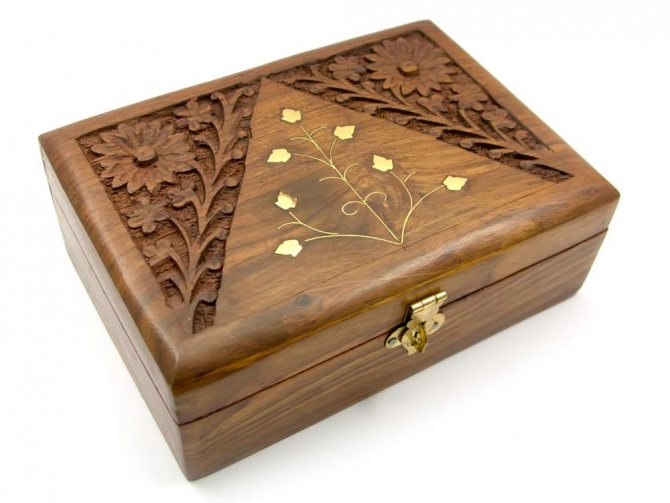

Polysandre box - Due to its strength wood easily amenable to polishing... From the prepared material are created musical instruments, parquet;
- Widely applied in medicine In South America.The plant is used to treat various infectious diseases. Flowers, fruits and leaves are used to make a mixture that helps the body fight infections. This medicine has no side effects.
Jacaranda is a beautiful tree with gorgeous flowers. Proper care of it, taking into account all the features of maintenance and reproduction, will ensure the growth of a healthy tree, which will delight you with its blooming appearance every day.
Diseases and pests
The most common plant disease is yellowed leaves. The reason may be a lack of iron in the soil. Be sure to feed the plant with an iron-containing fertilizer in the near future.
Watering too often can cause the jacaranda roots to rot. Also, poor drainage can be the cause of root rot. In order to save the plant, it must be transplanted into new soil as soon as possible.
Be sure to take care of a good drainage layer.
Possible problems
Jacaranda is considered an unpretentious plant. It is resistant to a large type of diseases and pests. However, there is a possibility of its defeat by such insects as whitefly, scale insects, aphids, spider mites.
Difficulties that may arise while growing a plant:
- With poor soil drainage, rotting of the root system is possible;
- Yellowing and curling of foliage. To prevent this phenomenon, it is necessary to treat the leaves with insecticides;
- Insufficient watering can cause chlorosis of the foliage;
- In winter and spring, the tree loses its leaves. This is considered a normal foliage renewal process.
Amaranth (Peltogyne)
The Amaranth tree belongs to the legume family (Latin Fabáceae) and the Caesalpiniaceae subfamily. Botanical name - Peltogyne spp., Peltogyne venosa. Another name is purple tree.
Amaranth is also called the Purple Heart, the tree got this name due to the color of its bark.
The genus includes 23 species of flowering plants native to the regions of Central and South America, where they are found in the rainforests of Brazil, Guyana and Suriname, with most of the species native to the Amazon.
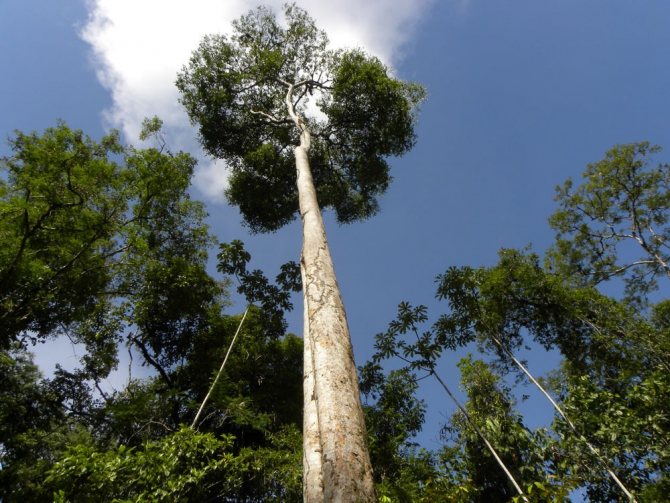

Botanical description
A tree growing 30-50 m in height, with a trunk diameter of up to 1.5 m. The leaves are alternate, divided into symmetrical pairs of large leaves 5-10 cm long and 2-4 cm wide. The flowers are small, with five white petals, gathered in panicle inflorescences. The fruit is a pod containing a single seed.


Wood
The sapwood is about 3 to 6 centimeters long and is brown with a noble bronze sheen. It is noteworthy that, initially, the heart core is gray-brown, and after sawing it acquires a rich purple hue. This is because the core is oxidized when it interacts with a humid environment and light. The pores are large enough and chaotically arranged, and the annual rings are barely noticeable. It has a medium-fine texture with good natural shine and a slightly wavy pattern.
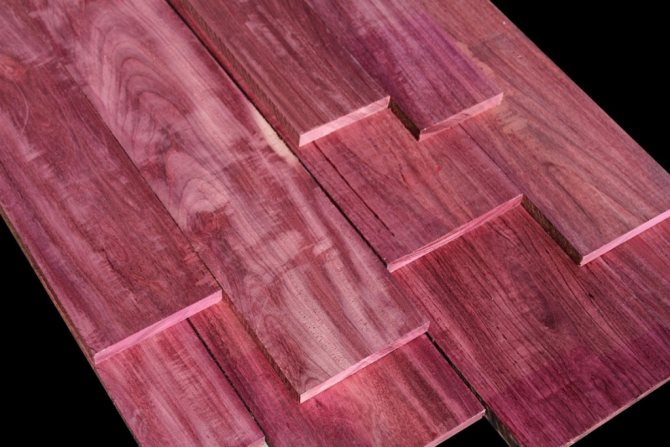

Mechanical properties of wood
Amaranth is a very hard, extremely dense (860 kg / m³) and waterproof wood. But, unfortunately, it has one significant drawback - fragility. Wood lends itself easily to any mechanical processing. However, it should be borne in mind that the tip of the tools can become dull over time, because gum is released from amaranth.
Dries quickly and does not require additional drying. It should also be borne in mind that the wood is compressed in the radial direction by 4.6%. In general, wood is resistant to weathering and has a second strength class. The Brinell hardness is 5.4 kgf / mm², and the flexural modulus is 16900 N / mm.
Amaranth wood is resistant to attacks of various insects and fungi, but it is influenced by sea molluscs. Allergy to Amaranth is extremely rare.
Application
Amaranth is extremely popular with consumers due to its expressive purple color. Amaranth board is used to make furniture and art objects. Excellent durability is another advantage of Amaranth. Therefore, it is used in areas where objects are subjected to constant stress. For example, they are used for flooring, cabins cladding or for the production of sports equipment.
Interesting Facts
The parquet floors of the Winter Palace in St. Petersburg are made of this particular type of wood.
Uncontrolled logging in areas of natural growth has put some amaranth species at risk of extinction.
In our store you can buy:
- natural veneer Amaranth
- amaranth bar
Useful properties of jacaranda
In addition to its aesthetic function, rosewood is also prized for its dense heartwood. It has a pronounced violet aroma, light gray tint and straight grain. When polished, the core takes on a noble color - from red-brown to chocolate-brown with a purple tint.
Due to its rather soft structure, the wood lends itself well to processing and dries easily. It is widely used in the production of luxury furniture, parquet, souvenirs and luxury goods - carved and inlaid with metal cups and bowls, bowling balls, as well as musical instruments. In Brazil, for example, acoustic guitars are made from it.
South American traditional medicine actively uses jacaranda to treat various infectious diseases. An aqueous extract from the leaves, fruits and flowers of the plant destroys Escherichia coli and Staphylococcus aureus more effectively than antibiotics, besides, the natural medicine has no side effects.
[collapse]
Accommodation
Jacaranda prefers bright lighting, for about 3 hours it tolerates the direct rays of the sun. The plant feels comfortable at the western and eastern windows. The pot must be rotated periodically as one-sided lighting can deform the crown.
The temperature required for the normal development of the plant in summer is +25 ° C, in winter - +19 ° C. In summer, Jacaranda loves to "walk" in the air. In this case, the place where you take the flower should be protected from the wind.
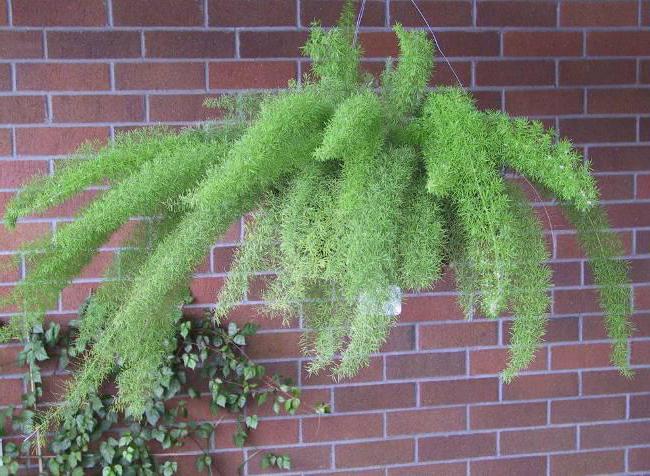

Reproduction at home
In Russian gardens, jacaranda cannot please the florist with its splendor due to the peculiarities of the climate. Therefore, such a plant is often grown at home as a mini-tree. Some even manage to make a bansai out of it, since the perennial has a well-defined trunk, even in miniature form. At home, flower growers are engaged in seed and vegetative propagation of jacaranda. Each of the methods has its own nuances, and which ones we will find out later.
First of all, try to find the optimal time. For propagation by seeds, the interval between the beginning of March and April is chosen. In the spring, you can provide enough sunlight for the sprouts. The nutrient mixture is taken soft, moisture-absorbing, but with a high content of sand for drainage. The tree loves moist, but not swampy soils. The ideal composition of the nutrient substrate is peat and sand.
The seeds are buried into the substrate by 1 cm. Further, in order for the planting material to give the first shoots, a temperature of 21-22 degrees is needed. To maintain the reading, cover the container with polyethylene or a glass cap. The first shoots will appear in about 2-4 weeks. Seedlings initially dive in small pots or cups with a diameter of 10 cm. In them, the plants are grown until several true leaves appear. In summer, you can transplant seedlings into permanent pots or outdoors.
Cutting jacaranda
If you want to do cuttings, then cut the stems from healthy adult plants.The stalk should be at least 5-8 cm. They can be dried for two hours, then treated with special root-forming compounds. Shoots are rooted in a nutritious peat substrate. Create a greenhouse environment by covering the plantings with glass or plastic covers before rooting.
Important: take young cuttings and only those that begin to wood. Planting material is cut from May to June. After rooting, the cuttings are transplanted into new pots, several pieces at a time for convenience. The next transplant is necessary only after the entire pot is filled with the roots of the plant. This procedure is carried out annually with partial or complete replacement of the nutrient soil.
Signs and superstitions
It is believed that jacaranda has a strong magical effect, so keeping it at home is extremely family friendly. It is a tree that brings beauty and good luck. It has a number of properties that cleanse the aura, fill the space with positive energy.
She brings wealth and prosperity. The violet tree clears negative thoughts, instills harmony and tranquility in the soul. However, some people feel apathy and sleepiness.
In Feng Shui, it is better to put jacaranda in wide spaces next to the windows. It is undesirable to place it next to the bed and resting place, in the kitchen or in the office.
Read also Tractor weight to 700
Signs associated with the flowering of the violet tree are also common. This process promises well-being, brings prosperity to the house and may indicate an imminent replenishment in the family.
When buying a plant, pay attention to your interior. Jacaranda cannot be in a tight and narrow space, it needs space. Do not forget in hot weather it is necessary to rearrange it in the shade, otherwise the leaves may turn yellow soon.
When buying, pay attention to the leaves - if they are yellowish at the edges, and the leaves themselves are slightly bent, then this plant may soon wither away.
Choose a violet tree with bright green leaves that give off a glossy sheen.
Fertilization and feeding
The best "nutrients" are fertilizers based on phosphorus and superphosphate. Lime is also recommended, but cannot be combined with acidified soil and alkaline fertilizers. It is better to use dry fertilizers, but you can add some concentrates.
Organic
Manure, bird droppings, peat, silt, sawdust and bark, green manure, compost.
Mineral
They are considered excellent helpers in processing the plant, strengthen it and provoke rapid growth.
- Potash.
- Phosphoric.
- Complex mineral fertilizers.
You can buy a mixture of peat and sand, compost, and various mineral fertilizers. Among them: "Superphosphate", "Ammophos", "Urea" and others.
Kornevin is a cream-colored powder, a small amount is used in dry form, suitable for dipping the end of the cuttings when transplanting for better rooting or rapid root development.
Heteroauxin is the main plant phytohormone that promotes active metabolism and prevents rapid leaf fall.
Fertilizers can be prepared at home by mixing natural ingredients with minerals.
It is necessary to feed during growth once every 2 weeks. For jacaranda, it is very useful to use organic fertilizers, alternating them with mineral fertilizers, even during a dormant period.
Jacaranda is watered with restraint, as it does not like excessive moisture. It needs abundant watering at the moment of active growth - from spring to autumn. The water should be at room temperature and soft, you can not pour cold water, as the violet tree can "get sick". In winter, you need to water less often, and in especially cold months up to once every 3-4 weeks.
Is jacaranda suitable for bonsai shaping?
The plant is used for growing according to Japanese bonsai technology. This allows you to control the growth of the crown and leaves, as well as create your own garden in miniature.There is even a separate variety of bonsai blue jacaranda, which does not reach more than 75 centimeters in length. For cultivation, the following conditions must be observed:
- in the first year you cannot cut it;
- in the second year, cut to 10 cm and wait for the appearance of side shoots;
- then pinch the jacaranda, pruning the leaves and crown;
- to form the crown, you can use a soft wire, which must be removed after 3 months;
- all large leaves are best cut off;
- jacaranda will tend to branch less poorly when standing in the shade.
Using
We have already mentioned that jacaranda is highly prized in the world. It is known for being used for the production of high-end furniture, unique luxury items (inlaid with metal and carvings). In addition, excellent musical instruments are made from this wood.
When polished, the core of the wood becomes a beautiful brown color with a purple sheen. For example, in Brazil, you can see and buy jacaranada souvenirs - carved figurines of exotic animals. They have a very pleasant delicate smell, especially when you wipe them with a cloth.
Homemade jacaranda transplant
Usually the plant is transplanted from March to May, but after increasing the roots so that it becomes cramped for them in the original container. If you decide to prepare a mixture for the soil with your own hands, you will need humus soil, turf soil, peat, sand (proportions one to two to one to one).
If you don't want to waste your energy and time, just purchase a potting soil mix from the market. It should include: peat, humus, leafy earth, sand, sod land (proportions two to two to four to two to one). It is necessary to prepare drainage at the bottom of the container.
Interesting facts related to the plant
The rosewood tree is not only an ornamental house plant. Certain types of this plant are especially valuable, because they are used in the production of many household items. The tree itself is incredibly heavy and durable, and most importantly expensive, which is why it is more appreciated.
Each city and state has its own signs and superstitions associated with jacarand. For example, in Australia, during the flowering of this tree, exams always begin, and the end of their studies. Therefore, this tree is often considered part of student cultures. In student circles, jacaranda is often referred to as an examination plant. Some students are convinced that the plant brings good luck, and the person on whom the rosewood whisk falls will successfully complete the academic year.
But, in the opinion of others - this tree is "lilac panic". There is a custom that indicates that while the jacaranda has not bloomed, it is far from the exams, and therefore prepares early. Well, when the flowers have already blossomed, it is time for exams and it is already too late to prepare. Despite being superstitious, all Australians take this plant very seriously.
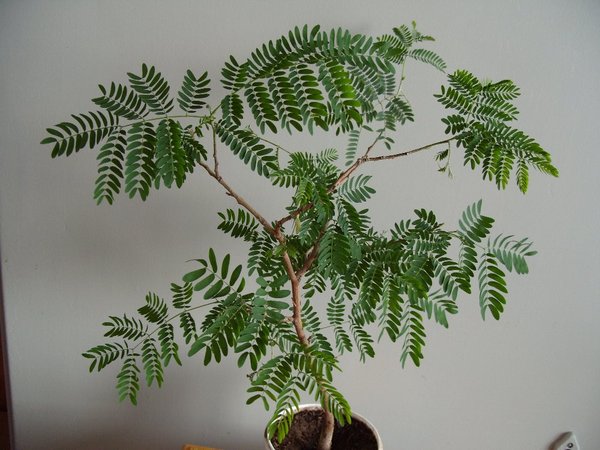

Also, for many Australian residents, jacaranda is considered a symbol of new life. Many are sure that after the birth of a baby, this tree simply needs to be planted on your site. No one can explain what exactly this custom is connected with, but it is known that it came from the 30s, when the shoots of these trees were given out simply in the maternity hospital at the time of discharge.



